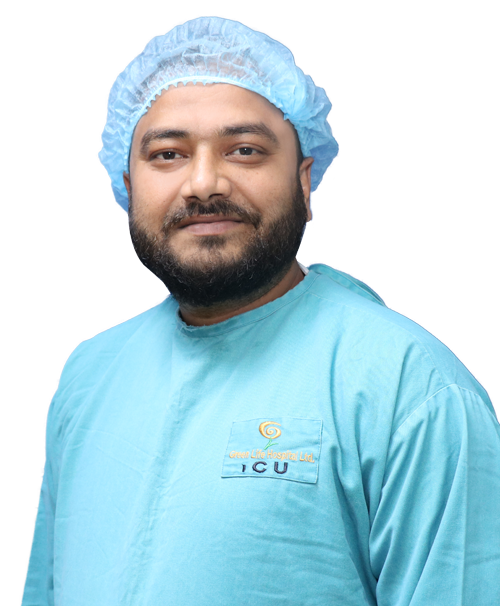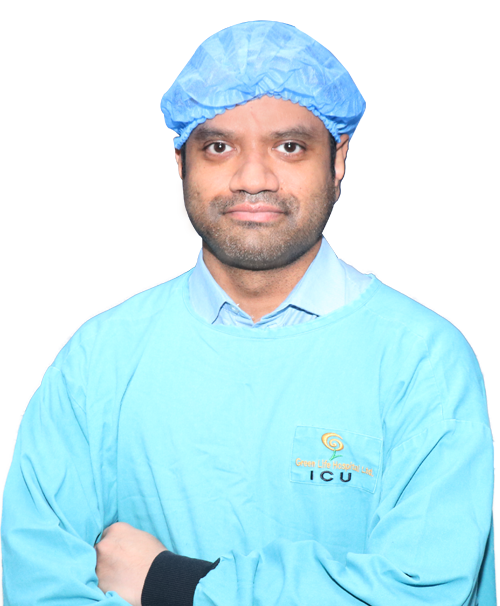
·
Intensive Care Unit (ICU))
· High Dependency Unit (HDU)
The Intensive care unit of Green Life Hospital offers Unit-1, Non COVID ICU and HDU unit and Unit-2, Covid ICU and HDU unit situated in level -5 , which deals with seriously ill patients who are cared for by specially trained doctors, nurses, respiratory therapists and dietitians. The department is operational 24/7 with every facility to serve the Critically Ill patient with utmost care. The ICU is well equipped with latest equipment required for optimum care of critically ill patients.
We
aspire to uphold the following morals
Compassion: We
care about the people we look after, care about each other and the work
Accountability: We understand
the responsibility of Dealing with sickest patient.
Respect: We
are very much friendly and respectful to everyone at all times.
Excellence: We
strive for excellence in every aspect of work.
Safety: We also ensure safety for staff and patients inside ICU
Criteria for ICU and HDU admission
ICU
1. Patients
requiring support for two or more organ systems (Acute flexible important of
>= 2 organs)
2. Patients
requiring Endotrachel intubation and invasive mechanical ventilator support
3. Patients
with Chronic impairemnet of one or more organ system who require support for
acute reversible failure of another organ
HDU
1. Patients
requiring detailed monitoring that cannot be provided in general ward :
a. BP
monitoring
b. CVP
monitoring
c. Fluid
balance
d. Regular
observation of GCS
e. ETcO2
in unconscious pt
2. Patients
requiring support for one organ system
3. Non-invasive
respiratory support
4. Moderate
inotrope or vasopressor support
5. Renal
replacement therapy in any stable patient requires monitoring
6. Step down from ICU
requiring additional monitoring or single organ support
The
Intensive Care Unit should be reserved for patients with reversible medical
conditions with a reasonable prospect of substantial recovery. Patients with
the following conditions are candidates for admission to the Intensive Care
Unit.
A. Breathlessness due to
a. Pneumonia
(Moderate to severe)
b. Acute
severe of COPD
c. Acute
exacerbation of Bronchial Asthma
d. Acute
exacerbation of DPLD
e. Pneumothorax
f.
Lung collapse
B. Unconsciousness due to
a. Hypoglycemia
b. Electrolytes
Imbalance
i. Hyponatramia
ii. hypernatramia
c. Uremic
Encephalopathy
d. Hepatic
encephalopathy
e. Type
2 Respiratory failure
C. Polytrauma like
a. Severe
head injury
b. chest
injury
c. Spinal
injury
d. Peripheral
limb injury
D. Poisoning
a. Alcohol/Methanol
b. Napa
c. Sedative
d. OPC
etc.
E. Respiratory
a. Acute
respiratory failure requiring (Severe Pneumonia) ventilatory support
b. Acute
pulmonary embolism with hemodynamic instability
c. Massive
hemoptysis
d. Upper
airway obstruction
F.
Cardiovascular
a. Acute
Myocardial infarction with Complication
b. Heart
failure
c. Shock
states
d. Life-Threatening
dysrhythmias with other manifestation
e. Dissecting
aortic aneurysms
f. Hypertensive
emergencies
g. Need
for continuous invasive monitoring of cardiovascular system (arterial pressure,
central venous pressure, cardiac output)
G. Neurological
a. Acute stroke/CVD
b. Severe
head Injury
c.
Status
epilepticus
d. Meningitis with altered mental status or respiratory
complications
e. Acutely altered sensorium with the potential for airway
compromise
f. Progressive neuromuscular dysfunction requiring respiratory
support and/or cardiovascular monitoring (myasthenia gravis, Gullain- Barre
syndrome)
g. GBS
h. Myasthenia Grins
i. Hypertension crisis (Emergency/Urgency)
j. Brain death or potentially brain dead patients who are being
aggressively managed while determining organ donation status Program
H. Renal
a. AKI
b. Requirement for acute renal replacement therapies in an unstable
patient
c. ESRD patient with Multiorgan disfunction
I. Endocrine
a. Diabetic
ketoacidosis complicated by hemodynamic instability, altered mental
status
b. Severe
metabolic acidotic states
c. Thyroid storm or myxedema coma with hemodynamic instability
d. Hyperosmolar state with coma and/or hemodynamic instability
e. Adrenal crises with hemodynamic instability
Other severe electrolyte
abnormalities, such as:
f. Hypo or hyperkalemia with dysrhythmias or muscular weakness
g. Severe hypo or hypernatremia with seizures, altered mental
status
h. Severe hypercalcemia with altered mental status, requiring
hemodynamic monitoring
J. Gastrointestinal
a. Life threatening gastrointestinal bleeding
b. Acute hepatic failure leading to coma, hemodynamic instability
c. Severe acute pancreatitis
d. Intestinal obstruction with abdominal compartment syndrome
e. Ac. Cholecystitis,
Ac. Appendicitis, Ac. Peritonitis perforation of hollow viscus
K. Hematology
a. Severe coagulopathy and/or bleeding diathesis
b. Severe anemia resulting in hemodynamic and/or respiratory
compromise
c. Severe complications of sickle cell crisis
d. Hematological malignancies with multi-organ failure
e. Neutopenic sepsis
f. DIC
g. Microangiopathic hemolytic anemia (MAHA)
L. Obstetric
a. Medical conditions complicating pregnancy
b. Severe pregnancy induced hypertension/eclampsia
c. Obstetric hemorrhage
d. Amniotic fluid embolism
M. Multi-system
a. Severe sepsis or septic shock
b. Multi-organ dysfunction syndrome
c. Polytrauma
d. Dengue hemorrhagic fever/dengue shock syndrome
e. Drug overdose with potential acute decompensation of major organ
systems
f. Environmental injuries (lightning, near drowning,
hypo/hyperthermia
g. Severe burns
N. Surgical
a. High risk patients in the peri-operative period
Post-operative
patients requiring continuous hemodynamic monitoring/ ventilatory support,
usually following:
b. Vascular surgery
c. thoracic surgery
d. airway surgery
e. craniofacial surgery
f. major orthopedic and spine surgery
g. general surgery with major blood loss / fluid shift
h. neurosurgical procedures
Consultants for Critical Care Unit

Dr. Mohammad Asaduzzaman
Consultant -
Critical Care Medicine (Intensive Care Unit)
Department -
Critical Care Unit

Dr. Khundkar Alamin Rumi
Speciality - Critical Care Medicine & Medicine
Consultant -
ICU & HDU, Critical Care Medicine
Department -
Critical Care Unit